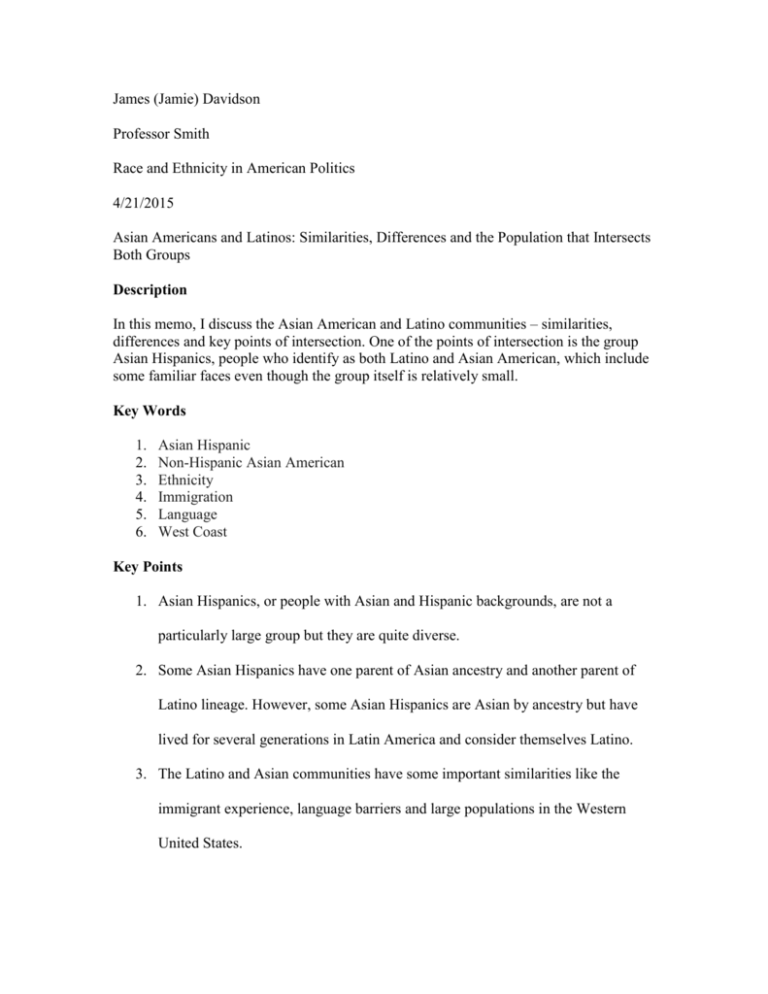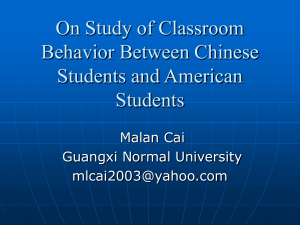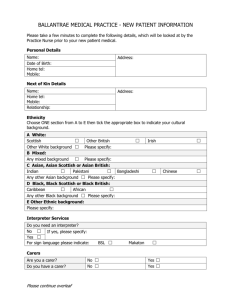Davidson_James
advertisement

James (Jamie) Davidson Professor Smith Race and Ethnicity in American Politics 4/21/2015 Asian Americans and Latinos: Similarities, Differences and the Population that Intersects Both Groups Description In this memo, I discuss the Asian American and Latino communities – similarities, differences and key points of intersection. One of the points of intersection is the group Asian Hispanics, people who identify as both Latino and Asian American, which include some familiar faces even though the group itself is relatively small. Key Words 1. 2. 3. 4. 5. 6. Asian Hispanic Non-Hispanic Asian American Ethnicity Immigration Language West Coast Key Points 1. Asian Hispanics, or people with Asian and Hispanic backgrounds, are not a particularly large group but they are quite diverse. 2. Some Asian Hispanics have one parent of Asian ancestry and another parent of Latino lineage. However, some Asian Hispanics are Asian by ancestry but have lived for several generations in Latin America and consider themselves Latino. 3. The Latino and Asian communities have some important similarities like the immigrant experience, language barriers and large populations in the Western United States. 4. There are key differences. Latinos lag behind Asian Americans in terms of average income and educational level. 5. Both groups are growing rapidly and are becoming larger political forces – even as their voter turnout and descriptive representation are disproportionately low. Issue Brief In this brief, I will first look at the group of Americans who identify as Asian and Hispanic. While small, this populace is very diverse and boasts some famous figures. I will then look at some of the similarities and differences in the Latino and Asian American communities. While distinct in many ways, Latinos and Asian Americans share important characteristics such as having a large population of immigrants, dealing with language barriers and rapidly growing as a political and economic force within the United States. Who Are Asian Hispanics? Bruno Mars Fred Armisen The population of Americans that identify as both Latino and Asian-American is a small but diverse group that includes some notable figures like Bruno Mars1 and Fred Armisen.2 This is not to say that all Asian Hispanics (as they are sometimes described) are the same or even similar in heritage. The term, Asian Hispanic, is broad because the terms, Hispanic and Asian American, are broad. The census defines Hispanic or Latino as an ethnicity distinct from race.3 Americans identify themselves as either Hispanic or Non-Hispanic and then select their race. While just over half of Hispanic Americans select white as their race, a third select ‘some other race’ and the rest choose African American, Native American, Asian American or multi-racial. Hispanics that choose Asian as their race number 209,128 or .4% of the entire Hispanic population. However, Hispanics who identify as more than one race including Asian raises the number of Asian Hispanics to 598,146. In the Asian-American community, there is thus a distinction between Non-Hispanic Asian Americans and Asian Hispanics with the former numbering 16,722,710 and the latter 598,146. When looking at the individuals who make up the Asian Hispanic community, it becomes clear that everyone’s story is unique. Bruno Mars, for example, is described as “Hawaiian-born to a father of Puerto Rican heritage and a mother from the Philippines.”4 Fred Armisen’s mother has Venezuelan ancestry while his father has both Japanese and German ancestors.5 Both of these individuals have distinct countries of origin in their families’ backgrounds but in America, they share a similar identity: Asian Hispanic. Mars 1 Picture comes from http://www.eonline.com/eol_images/Entire_Site/2012018/300.mars.ls.11812.jpg Picture comes from http://movies.mxdwn.com/wp-content/uploads/2014/11/10867874932612254ac313cc250e17e6664be9188fef22f91.jpg 3 Rest of Paragraph “2010 Census Briefs.” Overview of Race and Hispanic Origin: 2010, March 2011. http://www.census.gov/prod/cen2010/briefs/c2010br-02.pdf. 4 “Huffington Post.” What Race Is Bruno Mars?, November 12, 2012. http://www.huffingtonpost.com/megan-smolenyak-smolenyak/what-race-is-bruno-mars_b_2116984.html. 5 “Bio.” Fred Armisen Biography, n.d. 2 and Armisen are examples of Americans who have one parent who is of Asian descent and another parent who is Latino. However, some Americans come to have the Asian Hispanic identity in a way different than simply having parents of each background. The Chinese Exclusion Act of 1882 and subsequent laws like the Johnson-Reed Act of 1924 drastically reduced the number Asian immigrants allowed into the United States until 1965 when the immigration system was overhauled to be less discriminatory. 6 One consequence of this period of exclusion is that many Asians seeking economic opportunity immigrated to Central and South America instead of the United States. These people of Asian ancestry came to identify themselves as Latino and so when they and/or their descendants came to the United States, that dual Asian/Hispanic identity came with them. “Chinese Exclusion Act (1882).” Our Documents, n.d. http://www.ourdocuments.gov/doc.php?flash=true&doc=47. 6 Similarities and Differences In addition to looking at Asian Hispanics as a group, there’s great value in examining the similarities and differences of the Latino and Asian American experience. Both groups share certain similarities like a heterogeneous mixture of countries of origin and language barriers for recent immigrants. They have both experienced hostility to their immigrating to the United States though not always at the same time. There are certainly differences, however, such as the fact that Spanish is ubiquitous among Latino immigrants but Asian immigrants speak a wide range of languages. The number of immigrants that make up each community is different as well and affects how the groups see themselves. Both groups have traded off being the fastest growing minority group in the past with Asian Americans currently holding the advantage in terms of rate of growth. However, the population growth in both communities is coming for different reasons. Immigration only makes up 22% of the increase in the Latino population while 61% of the population growth of Asian Americans is fueled by immigration.7 There are some geographic similarities between the communities as the Western United States is home to a majority of both groups.8 In terms of political and economic influence, the story for Latinos is one of growing clout but still lagging in terms of proportional representation. The number of Latinos in elected office grew 53 percent between 1996 and 2011 but they still only make up 3 percent of the total number of elected officials.9 Latinos lag behind non-Hispanic whites in categories like employment and education level but are making great strides. Indeed, Hispanic businesswomen are 600 percent more likely to create a business than the average American. The political issues of the Latino community overlap significantly with the policy debates that tend to concern local, state and federal lawmakers: quality of education, support for small businesses and access to healthcare (where Latinos tend to have disproportionately high uninsured rates). Of course, the Latino community is heavily invested in the immigration debate but it would be a mistake to ignore their stake in other political discussions. Asian Americans have the highest percentage of college Anna Brown. “PewResearchCenter.” U.S. Hispanic and Asian Populations Growing, but for Different Reasons, June 26, 2014. 8 Latino demographics map found here: http://markettolatinos.com/demographic-economic-charts.html. Asian demographics map found here http://www.censusscope.org/us/map_nhasian.html. 9 (Next three sentences.) Cárdenas, Vanessa, and Sophia Kerby. “The State of Latinos in the United States.” Center for American Progress, August 8, 2012. https://www.americanprogress.org/issues/race/report/2012/08/08/11984/the-state-of-latinos-in-the-unitedstates/. 7 graduates (50.5%) of any ethnoracial group and highest household income ($70,644).10 There are, however, major disparities between different groups that make up the AsianAmerican community. At 5.9 percent of the population, Asian Americans (like Hispanic Americans) are major players in the American economy but lag behind in political representation (2% of the current Congress).11 Both Latinos and Asian Americans trail the African-American and White voting rates by about eighteen percentage points.12 The major question for both groups will be if they can translate their growing population share into political power by turning out voters. While there are differences between the Asian and Latino communities such as economic and educational levels, we can expect to see both groups asserting a greater amount of political influence moving forward. Works Cited/Websites “14 Important Statistics About Asian Americans.” Asian-nation, n.d. http://www.asiannation.org/14-statistics.shtml. “2010 Census Briefs.” Overview of Race and Hispanic Origin: 2010, March 2011. http://www.census.gov/prod/cen2010/briefs/c2010br-02.pdf. Anna Brown. “PewResearchCenter.” U.S. Hispanic and Asian Populations Growing, but for Different Reasons, June 26, 2014. C. Vann Woodward, ed., Mary Chesnut’s Civil War p. 463. “Asians and Pacific Islanders in the 113th Congress.” Infoplease, n.d. http://www.infoplease.com/us/government/113-congress-asians-pacificislanders.html. “Bio.” Fred Armisen Biography, n.d. http://www.biography.com/people/fred-armisen21313233. 10 “14 Important Statistics About Asian Americans.” Asian-nation, n.d. http://www.asian-nation.org/14statistics.shtml. 11 “Asians and Pacific Islanders in the 113th Congress.” Infoplease, n.d. http://www.infoplease.com/us/government/113-congress-asians-pacific-islanders.html. 12 Paula D. McClain and Joseph Stewart Jr. “Can We All Get Along?” (Boulder: Westview Press, 2014) p. 106 Cárdenas, Vanessa, and Sophia Kerby. “The State of Latinos in the United States.” Center for American Progress, August 8, 2012. https://www.americanprogress.org/issues/race/report/2012/08/08/11984/the-stateof-latinos-in-the-united-states/. “Chinese Exclusion Act (1882).” Our Documents, n.d. http://www.ourdocuments.gov/doc.php?flash=true&doc=47. “Huffington Post.” What Race Is Bruno Mars?, November 12, 2012. http://www.huffingtonpost.com/megan-smolenyak-smolenyak/what-race-isbruno-mars_b_2116984.html. McClain, Paula D. and Joseph Stewart Jr. “Can We All Get Along?” (Boulder: Westview Press, 2014) http://www.asian-nation.org/politics.shtml http://www.multiculturalmentalhealth.org/nlaas.asp http://www.nytimes.com/2012/06/19/us/asians-surpass-hispanics-as-biggest-immigrantwave.html?_r=0 http://www.cdc.gov/minorityhealth/populations/REMP/asian.html http://www.cdc.gov/minorityhealth/populations/REMP/hispanic.html Images http://www.eonline.com/eol_images/Entire_Site/2012018/300.mars.ls.11812.jpg http://movies.mxdwn.com/wp-content/uploads/2014/11/10867874932612254ac313cc250e17e6664be9188fef22f91.jpg http://markettolatinos.com/demographic-economic-charts.html http://www.censusscope.org/us/map_nhasian.html





